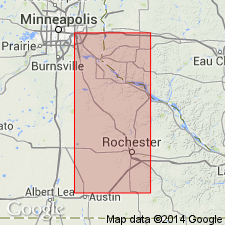
- Usage in publication:
-
- Richmond group
- Modifications:
-
- Original reference
- Dominant lithology:
-
- Shale
- Limestone
- AAPG geologic province:
-
- Cincinnati arch
Summary:
Pg. ciii. Richmond group. Alternating thin-bedded shales and limestones with, at some localities, a sandstone at top. Overlies Lorraine group and forms uppermost part of Lower Silurian [Ordovician] in southwestern Ohio, southeastern Indiana, and north-central Kentucky. Thickness 350 feet.
[Named from Richmond, IN.]
Source: US geologic names lexicon (USGS Bull. 896, p. 1809-1810).

- Usage in publication:
-
- Richmond group*
- Modifications:
-
- Overview
- AAPG geologic province:
-
- Cincinnati arch
- Illinois basin
- Ozark uplift
Summary:
In some early reports the Arnheim shale was excluded from Richmond group but for many years it has been included in the Richmond by most geologists and is so included by the USGS. In southeastern Indiana and southwestern Ohio, the Richmond group includes the deposits that have been called (descending) Elkhorn limestone, Whitewater formation, Saluda limestone, Liberty limestone, Waynesville shale, and Arnheim shale. In southern Illinois and eastern Missouri, it includes Maquoketa shale (and the contemporaneous Thebes formation) and the underlying Fernvale limestone.
The age of the Richmond group has been the subject of much discussion in recent years. Originally (1897) it was assigned to the Ordovician by Winchell and Ulrich. Subsequently it was thus classified by all geologist and paleontologists until 1911, when E.O. Ulrich (GSA Bull, v. 22) placed it in the Silurian. At present [ca. 1936] the group is classified as Ordovician by apparently all geologists and paleontologists except E.O. Ulrich, R.S. Bassler, and R. Ruedemann, but the present New York State Survey (W. Goldring, New York State Mus. Hdbk., no. 10, 1931) assigns Queenston shale (which is generally regarded as of Richmond age) to Silurian, and the present Pennsylvania Geological Survey assigns Juniata formation (= Richmond) to Silurian.
Source: US geologic names lexicon (USGS Bull. 896, p. 1810).
For more information, please contact Nancy Stamm, Geologic Names Committee Secretary.
Asterisk (*) indicates published by U.S. Geological Survey authors.
"No current usage" (†) implies that a name has been abandoned or has fallen into disuse. Former usage and, if known, replacement name given in parentheses ( ).
Slash (/) indicates name conflicts with nomenclatural guidelines (CSN, 1933; ACSN, 1961, 1970; NACSN, 1983, 2005, 2021). May be explained within brackets ([ ]).

